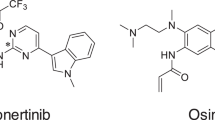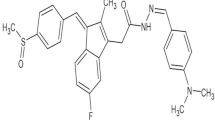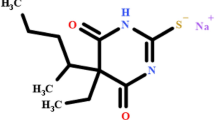Abstract
Aim:
To investigate the potential of houttuynin to covalently bind to proteins in vitro and in vivo and to identify the adduct structures.
Methods:
Male Sprague-Dawley rats were intravenously injected with sodium houttuyfonate (10 mg/kg). The concentrations of houttuynin in blood, plasma and five tissues tested were determined using an LC/MS/MS method. The covalent binding values of houttuynin with hemoglobin, plasma and tissue proteins were measured in rats after intravenous injection of [1-14C]sodium houttuyfonate (10 mg/kg, 150 mCi/kg). Human serum albumin was used as model protein to identify the modification site(s) and structure(s) through enzymatic digestion and LC/MSn analysis.
Results:
The drug was widely distributed 10 min after intravenous injection. The lungs were the preferred site for disposition, followed by the heart and kidneys with significantly higher concentrations than that in the plasma. The extent of covalent binding was correlated with the respective concentrations in the tissues, ranging from 1137 nmol/g protein in lung to 266 nmol/g protein in liver. Houttuynin reacted primarily with arginine residues in human serum albumin to form a pyrimidine adduct at 1:1 molar ratio. The same adduct was detected in rat lungs digested by pronase E.
Conclusion:
This study showed that the β-keto aldehyde moiety in houttuynin is strongly electrophilic and readily confers covalent binding to tissue proteins, especially lung proteins, by a Schiff's base mechanism. The findings explain partially the idiosyncratic reactions of houttuyniae injection in clinical use.
Similar content being viewed by others
Log in or create a free account to read this content
Gain free access to this article, as well as selected content from this journal and more on nature.com
or
References
Uetrecht J . Immune-mediated adverse drug reactions. Chem Res Toxicol 2009; 22: 24–34.
Baillie TA . Metabolism and toxicity of drugs. Two decades of progress in industrial drug metabolism. Chem Res Toxicol 2008; 21: 129–37.
Li AP . Overview: Evaluation of metabolism-based drug toxicity in drug development. Chem Biol Interact 2009; 179: 1–3.
Stepan AF, Walker DP, Bauman J, Price DA, Baillie TA, Kalgutkar AS, et al. Structural alert/reactive metabolite concept as applied in medicinal chemistry to mitigate the risk of idiosyncratic drug toxicity: A perspective based on the critical examination of trends in the top 200 drugs marketed in the United States. Chem Res Toxicol 2011; 24: 1345–410.
Kalgutkar AS, Soglia JR . Minimising the potential for metabolic activation in drug discovery. Expert Opin Drug Metab Toxicol 2005; 1: 91–142.
Zheng ZH . Clinical study on children respiratory tract infection treated by herba houttuyniae injection combination with antibiotics. Xibei Yao Xue Za Zhi 2006; 21: 33–4.
Sun GZ, Ju CD, Zhang XW, Yu RX . Investigation on clinical effect of herba houttuyniae injection by aerosol inhalation for respiratory tract infection on 107 cases. Chin Trad Pat Med 2001; 23: 421–3.
Wang XX . Twenty cases of adverse reaction caused by intravenous drop infusion of herba houttuyniae injection. Zhongguo Zhong Yao Za Zhi 2002; 27: 392–3.
Gao R, Wen WL, Tang XD . Adverse reaction and countermeasures of herba houttuyniae injection. Trad Chin Drug Res Clin Pharmacol 2006; 17: 383–5.
Du X, Shang J, Sun DF . Two cases with allergy induced by new sodium houttuyfonate. Chin J Pharmacoepidemiol 2004; 13: 349–50.
Liu JB, Cao RH, Wu QF, Ma CM, Wang ZH, Peng WL, et al. Synthesis and antibacterial evaluation of novel 4-alkyl substituted phenyl β-aldehyde ketone derivatives. Eur J Med Chem 2009; 44: 1737–44.
Kita T, Fujimura M, Myou S, Ishiura Y, Abo M, Katayama N, et al. Potentiation of allergic bronchoconstriction by repeated exposure to formaldehyde in guinea-pigs in vivo. Clin Exp Allergy 2003; 33: 1747–53.
Arican RY, Sahin Z, Ustunel I, Sarikcioglu L, Ozdem S, Oguz N . Effects of formaldehyde inhalation on the junctional proteins of nasal respiratory mucosa of rats. Exp Toxicol Pathol 2009; 61: 297–305.
Israel Y, MacDonald A, Niemelä O, Zamel D, Shami E, Zywulko M, et al. Hypersensitivity to acetaldehyde-protein adducts. Mol Pharmacol 1992; 42: 711–7.
Linneberg A, Gonzalez-Quintela A, Vidal C, Jørgensen T, Fenger M, Hansen T, et al. Genetic determinants of both ethanol and acetaldehyde metabolism influence alcohol hypersensitivity and drinking behaviour among Scandinavians. Clin Exp Allergy 2009; 40: 123–30.
Furuhata A, Ishii T, Kumazawa S, Yamada T, Nakayama T, Uchida K . Nɛ-(3-methylpyridinium) lysine, a major antigenic adduct generated in acrolein-modified protein. J Biol Chem 2003; 278: 48658–65.
Uchida K, Kanematsu M, Sakai K, Matsuda T, Hattori N, Mizuno Y, et al. Protein-bound acrolein: Potential markers for oxidative stress. Proc Natl Acad Sci U S A 1998; 95: 4882–7.
Lee SH, Blair IA . Characterization of 4-oxo-2-nonenal as a novel product of lipid peroxidation. Chem Res Toxicol 2000; 13: 698–702.
Aldini G, Gamberoni L, Orioli M, Beretta G, Regazzoni L, Facino RM, et al. Mass spectrometric characterization of covalent modification of human serum albumin by 4-hydroxy-trans-2-nonenal. J Mass Spectrom 2006; 41: 1149–61.
Roller SG, Dieckhaus CM, Santos WL, Sofia RD, Macdonald TL . Interaction between human serum albumin and the felbamame metabolites 4-hydroxy-5-phenyl-[1,3]oxazinan-2-one and 2-phenylpropenal. Chem Res Toxicol 2002; 15: 815–24.
Waldon DJ, Teffera Y, Colletti AE, Liu J, Zurcher D, Copeland KW, et al. Identification of quinone imine containing glutathione conjugates of diclofenac in rat bile. Chem Res Toxicol 2010; 23: 1947–53.
Baba A, Yoshioka T . Structure-activity relationships for degradation reaction of 1-β-O-acyl glucuronides: kinetic description and prediction of intrinsic electrophilic reactivity under physiological conditions. Chem Res Toxicol 2009; 22: 158–72.
Sanderson JP, Naisbitt DJ, Park BK . Role of bioactivation in drug-induced hypersensitivity reactions. AAPS J 2006; 8: 55–61.
Duan XT, Zhong DF, Chen XY . Derivatization of β-dicarbonyl compound with 2,4-dinitrophenylhydrazine to enhance mass spectrometric detection: Application in quantitative analysis of houttuynin in human plasma. J Mass Spectrom 2008; 43: 814–24.
Bradford M . A rapid and sensitive method for the quantitation of microgram quantities of protein utilizing the principle of protein-dye binding. Anal Biochem 1976; 72: 248–54.
Laemmli UK . Cleavage of structural proteins during the assembly of the head of bacteriophage T4. Nature 1970; 227: 680–5.
Kang B, Tong Z . A fast staining-destaining method for SDS-PAGE which favours the recovery of protein. Prog Biochem Biophys 2000; 27: 210–1.
Kapteyn JC, Montijn RC, Dijkgraaf GJP, Ende HVD, Klis FM . Covalent association of β-1,3-glucan with β-1,6-glucosylated mannoproteins in cell walls of Candida albicans. J Bacteriol 1995; 177: 3788–92.
Oe T, Lee SH, Elipe MVS, Arison BH, Blair IA . A novel lipid hydroperoxide-derived modification to arginine. Chem Res Toxicol 2003; 16: 1598–605.
Oya T, Hattori N, Mizuno Y, Miyata S, Maeda S, Osawa T, et al. Methylglyoxal modification of protein. Chemical and immunochemical characterization of methylglyoxal-arginine adducts. J Biol Chem 1999; 274: 18492–502.
Stepan AF, Walker DP, Bauman J, Price DA, Baillie TA, Kalgutkar AS, et al. Structural alert/reactive metabolite concept as applied in medicinal chemistry to mitigate the risk of idiosyncratic drug toxicity: A perspective based on the critical examination of trends in the top 200 drugs marketed in the United States. Chem Res Toxicol 2011; 24: 1345–410.
Acknowledgements
This work was supported by the grants from the National Natural Science Foundation of China (No 90709036 and No 81173117). We would like to thank Prof Jiang ZHENG at the University of Washington (Seattle, WA, USA) for helpful discussions about radioactivity research and Ms Cen XIE of our laboratory for assistance in the in vivo covalent binding assay.
Author information
Authors and Affiliations
Corresponding author
Rights and permissions
About this article
Cite this article
Deng, Zp., Zhong, Df., Meng, J. et al. Covalent protein binding and tissue distribution of houttuynin in rats after intravenous administration of sodium houttuyfonate. Acta Pharmacol Sin 33, 568–576 (2012). https://doi.org/10.1038/aps.2011.174
Received:
Accepted:
Published:
Issue date:
DOI: https://doi.org/10.1038/aps.2011.174
Keywords
This article is cited by
-
Sodium houttuyfonate in vitro inhibits biofilm dispersion and expression of bdlA in Pseudomonas aeruginosa
Molecular Biology Reports (2019)



